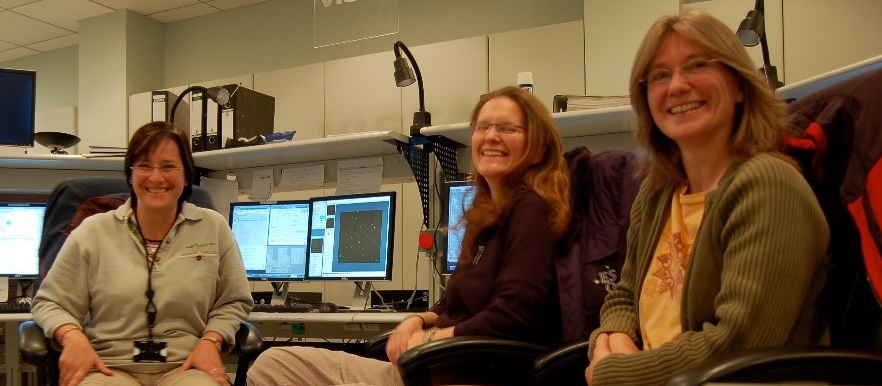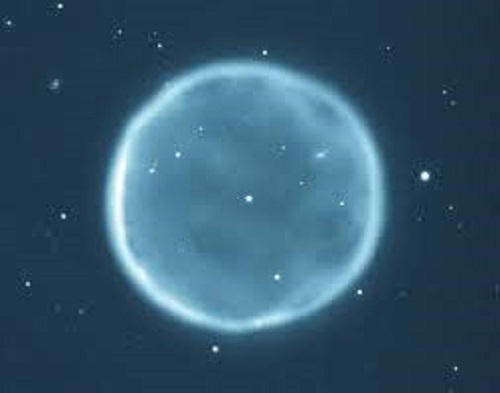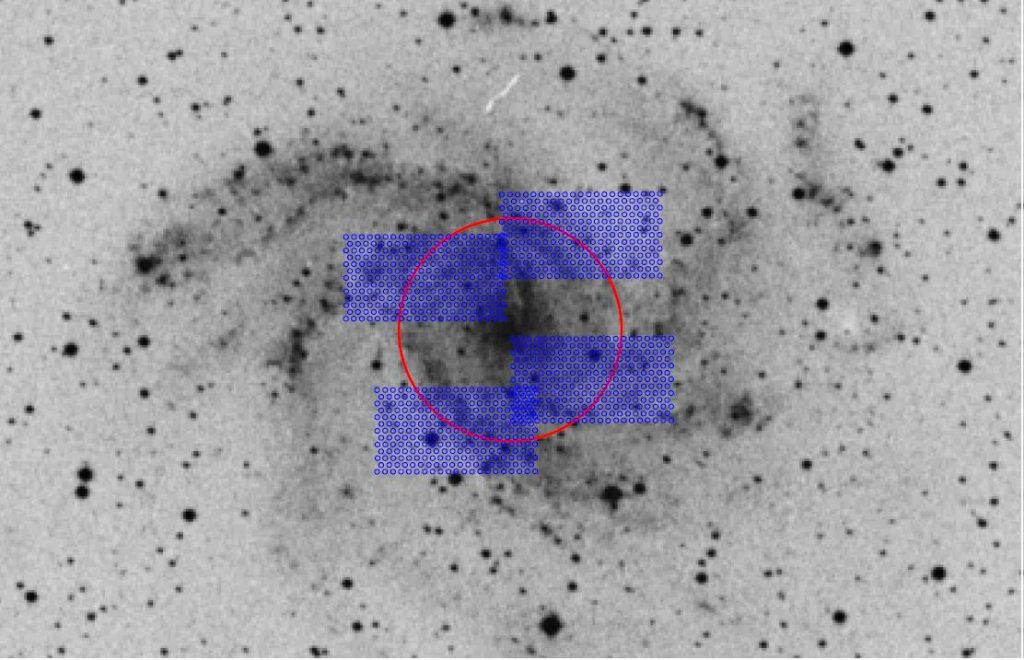Magda Arnaboldi
December 14, 2020 · 8 min read
Ex Novo – Science behind the scenes
“Ex Novo – Science behind the scenes” is a series of articles born within ISA’s blog in collaboration with the Collegio Nuovo – Fondazione Sandra e Enea Mattei in Pavia, whose students community is marked by a strong presence of women in science. Science is research, long hours to carry out experiments in the laboratory or in the field, but science is also communication, grant writing, entrepreneurship, administration, teaching, project management, leadership and many other facets. We will post articles, interviews and short stories on these multiple aspects of the scientific endeavour. Should you like to contribute with your experience, do not hesitate to get in touch with Michela, ISA’s Head and Collegio Nuovo Alumna, here: michela.bertero@crg.eu.
A career path among stars and dark matter
For this new article, I interviewed Magda Arnaboldi, astronomer at the European Southern Observatory (ESO), with a strong passion for stars since early on in her life. We explored with her the challenges behind the scenes of being a woman scientist, the importance of role models and perseverance.
How did you start to look at the stars?
This is a good question. I became aware of the sky, the Moon and the stars rather early in my life, like six to eight years old. The occasion was at an old farmhouse in the mountains that my family owned, about one hour drive from the town where we lived. Despite being not very far, it was an isolated secluded place, and very, very dark at night. Back then, there was no electricity there, and on a dark winter night, with the mountains covered by white snow, the stars in the dark sky were so impressive! A spectacle that could not be ignored. I could also notice that there were some very bright stars that were visible at sunset and no one in my family circle was able to tell me what these lights were. Now I know they were the planets, Venus, Jupiter and Saturn, but back then, I was enchanted and curious.
In the summer time, there was the Milky Way on the top of my head …“La via lattea”… but then, what was it? Why is it so elongated? Why does one see it in the summer and not in the winter? Why do the constellations change during the year? I was fascinated, I had all these questions. I guess answering these questions was a strong motivation to become interested in science – Physics and Astronomy. The “professional” observations of the sky came much later, while doing the Ph.D. I went observing at Asiago and at the La Silla Observatory on the Danish 1.5 meter telescope. I did not have any more doubts that astronomy was what I wanted to work on.
When you were a student in physics at the University of Pavia, you wrote in an article for your Collegio Nuovo: “In the cultural and university world there has never been a lack of illustrious women, but they were acute loners, behind whom there was no circle of similar scholars. [..] We must ensure that women learn to study together and collaborate with each other “. What would you say now about women in science and their ability to collaborate?
I think the landscape in STEM is certainly improving and we ought not to give up on making it better still. This year we celebrate the Nobel Prize for chemistry of two female scientists who have been working in France and USA and were collaborating – perhaps competing in a positive way – since many years. The two scientists are Dr. Emmanuelle Charpentier and Dr. Jennifer A. Doudna. Another recipient of the Nobel Prize in Physics is my colleague, Dr. Andrea Ghez from the University of California, Los Angeles, USA. It is very interesting to read their interviews: they all communicate the awareness of the importance of such an award, not so much for themselves, but for motivating and inspiring younger talented women. A life in science, in research, can be their life too, and they can excel in it. Let us not forget that role models are very important, and women can aspire to anything they wish to accomplish. Some time ago, I think I read about a man stating that a woman studying physics did not have many chances beyond becoming a teacher somewhere in high schools. The reply to this statement was that a woman with a degree in Physics could aspire to become the Chancellor of the Federal Republic of Germany, hence a person with authority, drive and power (Dr. Angela Merkel has a degree in Physics). It is important to aim high!

Fig. 1 : Magda (left) with Dr Marina Rejkuba (center, Head, User Support Department) and Dr Monika Pert-Götzen (right) in the VLT control room of the Paranal Observatory in Chile during the Science Verification run with the VISTA telescope.
Have you promoted initiatives to engage women in your field of research that is usually considered a male-dominated science?
I have been very privileged to work in an international environment with motivated and stimulating colleagues, collaborators and students. In my research, I supervised 13 Ph.D. students and 6 master students. Of these, 10 Ph.D. students were female and 3 Master students were female. I did not “deliberately’’ choose a larger fraction of women, I think it was a mutual fit: they were interested in the projects, and they felt that they could trust me as their supervisor. It was not always easy: astronomy is a competitive subject, with milestones and deadlines. I am very happy to say that all students who worked with me managed to submit and obtain their degree with flying colours, and many of them succeed to advance in academia and continued doing excellent research.
Can you tell us three role models (male/female) which have been important in your professional development and why?
I had an excellent teacher at the elementary school. Her name was Eva Sardo. She made us work a lot and she was very honest and straight. At high school, I had a professor in Physics who was known for being biased against girls. He was quoted to have said that it did not matter how long and hard a girl studied physics, she would never understand it. I do not think he could say now openly what he said then. In any case, when he was explaining physics, or astronomy, he was communicating his deep interest and love for the subject. Still he was terrible in the way he managed the human side of teaching.
I would like to conclude with my mentor, Professor Kenneth Freeman, from the Australian National University. I started to work with him in 1993, immediately after my Ph.D. when I got a postdoctoral position at the Mount Stromlo Observatory in Australia. It has been an honour and a privilege to learn from and work with him. I still find it so stimulating and interesting; we are working together and publishing papers for nearly 30 years.
How did you manage to face a challenging situation in your career?
With stubbornness … never ever give up.
You are engaging in opening up research not only to women but also to the overall international community. Could you explain the tasks and goals of the Archive Science Group and describe your position as Head of this team?
The Archive Science group is the gatekeeper of the ESO science archive facility. Our role is to support the scientific content of the archive, which means that our users can carry out science with the data they access, and download it directly from this facility, instead of accessing telescopes. Said in other words, all the impressive sophisticated facilities in the La Silla Paranal Observatory in Chile produce arrays of numbers, which must be translated in physical quantities so that the scientists can do their science: for example, to discover a galaxy at redshift 7 or resolve the Electromagnetic echo from the gravitational waves generated by the merging of a neutron star binary system. To do so, we document and establish standard across instruments and techniques such that data can be found by setting constraints in the physical quantities, like energy, signal-to-noise, or wavelength interval/resolution. In addition, having science products in this format allows building interactive and intuitive web interfaces that allow accessing these hidden treasures. As Head of the team, I work with talented and motivated individuals, I am responsible for setting their goals, organising the work, making progress according to an agreed timeline and support them by making sure that they know what their tasks are and secure the resources so that they can do their job in the best conditions. For those who would like to explore the content of the ESO archive have a look here: http://archive.eso.org/scienceportal/home.
To conclude, tell us about your latest exciting discoveries. “Finally (after 50 years) we know that the stars dominate the gravity in the inner parts of the galaxies, but the dark matter totally dominates in their outer parts”. How would you tell this story to a young girl looking fascinated at the stars?
Let´s introduce the topic step-by-step.
Back in 1970, Ken Freeman himself in a seminal paper pointed out that the rotational velocities in disc galaxies were larger than expected given the mass associated with the stars, which emit the light in these systems. Because stars do not fly out in the empty space, some force must bind them in centripetal equilibrium, i.e. they go around more or less in a circular orbit around the centre of the galaxy. The mass contributing to the gravitational force must be in some form that does not emit nor absorb light. Hence, the name of “dark matter” (although invisible is more like it). From the results coming from cosmology, we also know that dark matter is not constituted of the same building blocks out of which atoms and ourselves are made of. With very big computers, it has been possible to simulate the evolution of the dark matter in our universe since the big bang, and study the formation of structures, i.e. galaxies. An intriguing result is that dark matter would concentrate very much towards the centre of the galaxies creating a so-called cusp.
Still one of the big uncertainties in mapping the amount of mass of galaxies has been how much of the gravity is provided by dark matter and how much by visible stars. It is easy to measure the total gravity: gravity provides the centripetal force that balances the rotation of the stars and gas in their nearly circular orbit around the centre of a galaxy, as said before. By measuring the rotational velocity out to large radii, we can measure the gravity and the galaxy’s total mass. What it is not so easy is to measure how much of this force comes separately from the dark matter and from the visible stars. This is vitally important, because the only way that we can learn about the properties of dark halos is through their gravity. By determining how much the stars contribute, we can work out the detailed structure of dark matter, almost as if we could see this invisible matter directly.
And, how did astronomers measure the pull from the stars?
As the stars circle the centre of the disc galaxy, they also oscillate up and down vertically from the plane of the disc. These motions are like that of an elastic spring: the star is kicked out of the plane by interacting with clouds of gas molecules and the spiral arms. Instead of flying away in space, the stars are pulled back towards the disc by the gravity of the remaining stars in the disc. Measuring these vertical motions in face-on disc galaxies allow us to measure the mass density of the stars and gas alone.
One complication comes from the different generations of stars that build discs like superposed layers. The younger stars, recently born from gas in the disk, move around in a very thin layer, in almost circular orbits. Older stars acquire more vertical motions: as they age, they are kicked here and there by inhomogeneity in the disc. It is the old populations of stars, though, that allow us to measure the total surface densities in the disc. Hence, one would like to measure the velocities of the older stars as they oscillate up and down the disc, and how far out they reach in their motions, to measure the stellar mass density of the disc.
The next crucial step is to measure these oscillatory motions over a large radial interval in the disc – only in this way the astronomers are sure to have a reliable measurement of the mass density of the stars.
Here comes another question. What stars should astronomers choose?
Astronomers have long known about planetary nebulae. These are the late phases of Sun-like stars: they are blowing off an envelope of gas, which gives off a green glow of an aquamarine hue from its oxygen atoms (Figure 2). The motions of these stars along the line of sight are relatively easy to measure from their Doppler shift, because of the bright green oxygen line emitted by their envelope. Furthermore, as the disc becomes fainter at larger distances from its centre, the planetary nebulae become easier to detect and can be used as beacons to trace the stellar motions out to large distances from the galaxy centres, where the total starlight is too faint to analyse. For this quest, i.e. the detection of planetary nebulae in the outer reaches of any galaxy, the accuracy of the Planetary Nebulae Spectrograph is key to deliver such difficult identifications and measurements.

Fig. 2: Image of the planetary nebula Abell 39.
…and finally your teamwork, Magda…
A team of astronomers with whom I am collaborating set themselves to measure the stellar motions in the disc galaxy NGC 6946, using the spectra of the total star light in the bright central regions (Figure 3) and hundreds of individual planetary nebulae as dynamical tracers in the outer parts. They were able to map the motions perpendicular to the disc over a large radial interval in the disc, equivalent to more than four disc scale lengths.
The team found that the visible disc of NGC 6946 contributes most of the radial gravitational field in the inner parts of the galaxy. The gravitational pull of the stars and gas accounts for 75% of the measured rotational velocity in this spiral galaxy, in accordance to what is found for the Milky Way. This is a very important result because it shows that the stars dominate within the optical boundaries of such galaxies, similarly to what has been found independently for our galaxy, the Milky Way.
In summary, the stars dominate the gravity in the inner parts of the galaxies, but the dark matter totally dominates in their outer parts. Our next challenging step is to work out why this is so.

Fig. 3: The spiral galaxy NGC 6946, from a Digital Sky Survey (DSS) image. The positions of the four VIRUS-W IFU fields used for the integrated light measurements are shown in blue. The red circle shows the separation between our inner and outer radial bins for the integrated light.
The scientific results of this research project are published in S Aniyan, A A Ponomareva, K C Freeman, M Arnaboldi, O E Gerhard, L Coccato, K Kuijken, M Merrifield, 2020, “Resolving the Disc-Halo Degeneracy II: NGC 6946”, MNRAS, accepted for publication. Paper: DOI.
A press release was published by the Australian National University “Scientist see the dark side of our galaxy”, Australian National University press release, 11 November 2020; and on the Isaac Newton Group web news.